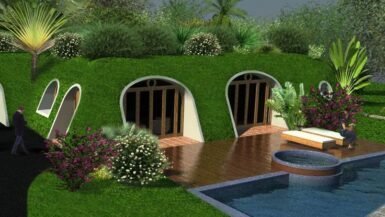In today’s world, the concept of sustainable living is gaining immense traction, and with good reason. As we become more environmentally conscious, designing sustainable tiny homes has emerged as an effective solution to reduce our ecological footprint. One crucial aspect of such homes is the creation of an eco-friendly bathroom that efficiently utilizes resources while offering the comfort of a traditional bathroom. In this article, we delve into the core aspects of creating a sustainable tiny home bathroom, discussing everything from water conservation to the use of eco-friendly materials. Join us as we explore practical tips, innovative ideas, and expert insights that will guide you in your journey towards a greener, more sustainable bathroom for your tiny home.
Eco-friendly Bathroom Fixtures: Choosing Water-Saving Toilets and Showers
Creating a sustainable tiny home bathroom involves careful consideration of the fixtures that you install. By selecting eco-friendly options, you can significantly reduce water consumption and contribute to a more sustainable future. In this subsection, we explore water-saving toilets and showers, providing guidance on making the best choice for your tiny home bathroom.
Water-Saving Toilets: Types and Technologies
Traditional toilets can consume a significant amount of water, but several water-saving alternatives are available in the market. Some popular options include:
1. Dual-flush toilets: These toilets allow users to choose between a full flush and a partial flush, saving water by using only the required amount for each use.
2. Low-flow toilets: Designed to use less water per flush, low-flow toilets are an effective way to save water without sacrificing performance.
3. Composting toilets: By converting human waste into compost, these toilets eliminate the need for water altogether, offering an environmentally friendly solution for waste disposal.
Research the different types and technologies available, and consider factors such as cost, maintenance, and space requirements before making a decision.
Efficient Showerheads: Reducing Water Consumption While You Shower
Showers account for a significant portion of household water usage, making it essential to choose a water-efficient showerhead for your tiny home bathroom. Some options to consider include:
1. Low-flow showerheads: These showerheads reduce water flow without compromising on pressure, ensuring an enjoyable shower experience while conserving water.
2. Shower timers: Installing a shower timer can help you monitor your water usage and encourage shorter showers, leading to reduced consumption over time.
3. Smart shower systems: Advanced smart shower systems allow users to preset water temperature and flow, ensuring minimal water wastage and maximum comfort.
Consider your budget, preferences, and the available space in your bathroom when choosing the most suitable water-saving shower option.
Selecting Faucets and Other Bathroom Fixtures
Beyond toilets and showers, other bathroom fixtures such as faucets can also contribute to water conservation. Opt for faucets with aerators that mix air into the water stream, reducing water flow without affecting pressure. Touchless or motion-activated faucets can also help minimize water waste by ensuring that water flows only when needed.
When designing your sustainable tiny home bathroom, prioritize fixtures that contribute to water conservation, energy efficiency, and overall sustainability. By doing so, you’ll create a space that is not only comfortable and functional but also kind to the environment.
Sustainable Materials for Tiny Home Bathroom Design and Construction
When it comes to creating a sustainable tiny home bathroom, selecting eco-friendly materials for design and construction is of paramount importance. By incorporating sustainable materials, you can reduce the environmental impact of your tiny home and promote a healthier living space. In this section, we explore various sustainable materials suitable for tiny home bathroom design and construction, providing insights on their benefits and potential applications.
Recycled and Reclaimed Materials: Giving New Life to Old Resources
Using recycled and reclaimed materials in your tiny home bathroom design not only helps minimize waste but also adds a unique touch of character to your space. Some popular options include:
1. Recycled glass tiles: These tiles, made from post-consumer glass, are a stylish and eco-friendly choice for bathroom walls and floors.
2. Reclaimed wood: Salvaged from old buildings, barns, or pallets, reclaimed wood can be used for bathroom vanities, shelves, and other fixtures.
3. Recycled metal: Reused metal materials, such as copper or aluminum, can be fashioned into sinks, faucets, and other bathroom fittings.
By opting for recycled and reclaimed materials, you can reduce the demand for new resources and contribute to a circular economy.
Biodegradable and Renewable Materials: Supporting Sustainable Sourcing
Utilizing biodegradable and renewable materials in your tiny home bathroom design ensures that your choices have a minimal environmental impact. Some examples of sustainable materials include:
1. Bamboo: This fast-growing renewable resource can be used for bathroom flooring, cabinetry, and other fixtures, offering a durable and eco-friendly alternative to traditional hardwood.
2. Cork: Harvested from the bark of cork oak trees, cork is a sustainable and versatile material suitable for bathroom flooring and walls.
3. Linoleum: Made from natural materials like linseed oil, wood flour, and cork dust, linoleum is a biodegradable flooring option that is both durable and easy to maintain.
By incorporating biodegradable and renewable materials in your tiny home bathroom, you are supporting sustainable sourcing practices and ensuring that your bathroom has a low environmental impact.
Non-Toxic Materials: Promoting Healthier Living Spaces
Choosing non-toxic materials for your tiny home bathroom is not only better for the environment but also contributes to healthier living spaces. Consider using the following non-toxic materials:
1. Low-VOC paints: Opt for low-VOC (volatile organic compounds) paints for your bathroom walls to minimize indoor air pollution and promote better air quality.
2. Non-toxic adhesives and sealants: Choose eco-friendly adhesives and sealants to reduce the release of harmful chemicals during installation and maintenance.
3. Natural stone: Using natural stone materials like granite, marble, or slate for countertops and flooring ensures durability without the need for harmful chemicals or treatments.
By selecting non-toxic materials for your tiny home bathroom, you are not only protecting the environment but also promoting a healthier living space for you and your loved ones.
Ultimately, incorporating sustainable materials into your tiny home bathroom design and construction is an essential aspect of creating a truly eco-friendly space. By carefully considering your choices and opting for materials that are recycled, renewable, and non-toxic, you can create a beautiful, functional, and sustainable bathroom that aligns with your green living goals.
Innovative Space-Saving Solutions for Small, Green Bathrooms
Designing a sustainable tiny home bathroom often requires innovative space-saving solutions to maximize functionality without compromising on eco-friendliness. In this section, we explore a variety of creative ideas and techniques to help you make the most of your small bathroom space while keeping sustainability at the forefront of your design.
Utilizing Vertical Space for Storage and Decor
In a small bathroom, every inch of space counts. One way to optimize your tiny bathroom is by taking advantage of vertical space for storage and decor. Some ideas to consider include:
1. Wall-mounted shelves: Install floating shelves or narrow wall cabinets to store bathroom essentials without taking up valuable floor space.
2. Over-the-toilet storage: Make use of the area above the toilet by adding shelves or cabinets for additional storage.
3. Hanging planters: Incorporate greenery into your bathroom with hanging planters, which not only save space but also purify the air and add a touch of nature to the room.
By focusing on vertical space, you can create a well-organized and visually appealing bathroom without sacrificing sustainability.
Multi-Functional Furniture and Fixtures
When space is limited, opting for multi-functional furniture and fixtures can help you make the most of your tiny bathroom. Some innovative ideas include:
1. Convertible shower/bathtub: A shower/bathtub combo allows you to enjoy the benefits of both a shower and a bathtub without taking up extra space.
2. Fold-down sink: A fold-down sink or vanity can be stowed away when not in use, freeing up valuable floor space.
3. Storage mirrors: Mirrors with built-in storage or medicine cabinets can help declutter your bathroom while providing a functional and stylish solution.
By selecting multi-functional furniture and fixtures, you can optimize your bathroom space while maintaining a sustainable and eco-friendly design.
Maximizing Natural Light and Creating Illusions of Space
A well-lit bathroom can create the illusion of a larger space while also reducing the need for artificial lighting. Some strategies for maximizing natural light in your tiny bathroom include:
1. Skylights: Installing a skylight can bring in an abundance of natural light, making the space feel more open and airy.
2. Reflective surfaces: Using reflective materials, such as mirrors or glossy tiles, can help bounce light around the room, making it appear brighter and more spacious.
3. Light colors: Opt for light-colored paint, tiles, and fixtures to create a sense of openness and make your tiny bathroom feel more expansive.
By focusing on natural light and creating illusions of space, you can create a bright, inviting bathroom that also conserves energy and supports your sustainability goals.
Implementing innovative space-saving solutions in your tiny home bathroom not only allows you to maximize the available space but also ensures that your bathroom remains eco-friendly and sustainable. By utilizing vertical space, incorporating multi-functional furniture and fixtures, and maximizing natural light, you can create a small, green bathroom that is both functional and visually appealing.
Natural Lighting and Ventilation Techniques in Compact Bathroom Spaces
Designing a sustainable tiny home bathroom requires a thorough understanding of how to harness natural light and ventilation in compact spaces. By focusing on these components, you can create a bright, airy bathroom that not only conserves energy but also promotes a healthy living environment. In this subsection, we will explore various techniques and strategies to effectively utilize natural lighting and ventilation in your tiny home bathroom, ensuring that your space is both eco-friendly and comfortable.
Maximizing Sunlight with Strategic Window Placement
The strategic placement of windows in your tiny home bathroom can significantly enhance natural lighting, reducing the need for artificial light sources during the day. Consider the following tips for effective window placement:
1. Position windows in the upper part of the wall: This allows sunlight to penetrate deeper into the room without compromising privacy.
2. Choose windows with a high visible light transmittance (VLT): This ensures that the maximum amount of sunlight enters your bathroom, creating a brighter environment.
3. Install frosted or textured glass: This option provides ample natural light while maintaining privacy.
By carefully considering window placement, you can create a well-lit bathroom that relies primarily on sunlight, reducing energy consumption and promoting sustainability.
Incorporating Ventilation Options for Improved Air Quality
Proper ventilation is essential in any bathroom, particularly in a tiny home, where humidity and moisture can quickly accumulate in compact spaces. Some effective ventilation techniques include:
1. Operable windows: Incorporate windows that can be opened to allow fresh air to circulate, promoting a healthier indoor environment.
2. Exhaust fans: Install energy-efficient exhaust fans to remove excess moisture and unpleasant odors, ensuring that your bathroom remains fresh and mold-free.
3. Passive ventilation: Consider designing your bathroom layout in a way that encourages natural airflow, such as using louvers or vents positioned to facilitate cross-ventilation.
By prioritizing proper ventilation in your tiny home bathroom, you can maintain a comfortable and healthy living space while minimizing energy consumption.
Enhancing Natural Light with Reflective Surfaces and Color Choices
In addition to window placement, using reflective surfaces and selecting the right color palette can significantly enhance natural lighting in your bathroom. Consider the following strategies:
1. Install mirrors strategically: Position mirrors in a way that reflects sunlight, amplifying the available natural light and creating a brighter space.
2. Choose light-colored materials: Opt for light-colored paint, tiles, and fixtures to create a sense of openness, while also reflecting sunlight to enhance natural lighting in your bathroom.
3. Utilize glossy or mirrored surfaces: Incorporate glossy tiles or mirrored surfaces to further increase the amount of light reflected in your bathroom, creating a more spacious and well-lit environment.
Through the strategic use of reflective surfaces and the right color choices, you can effectively enhance natural lighting in your tiny home bathroom, contributing to a more sustainable and pleasant living space.
By focusing on natural lighting and ventilation techniques, you can create a sustainable tiny home bathroom that is not only energy-efficient but also comfortable and inviting. By maximizing sunlight through strategic window placement, ensuring proper ventilation, and enhancing natural light with reflective surfaces and color choices, your tiny home bathroom will be a shining example of eco-friendly design.
Graywater Recycling Systems: An Essential for Tiny Home Bathrooms
Creating a sustainable tiny home bathroom goes beyond selecting eco-friendly fixtures and materials; it also involves rethinking how we manage and utilize water resources. Graywater recycling systems provide an innovative solution for conserving water in tiny home bathrooms, transforming used water from sinks, showers, and washing machines into a valuable resource for irrigation, toilet flushing, and other purposes. In this subsection, we delve into the benefits of graywater recycling, and explore various system options and their applications in tiny home bathrooms.
The Benefits of Graywater Recycling for Tiny Home Living
Incorporating a graywater recycling system into your tiny home bathroom offers numerous environmental and practical benefits, including:
1. Water conservation: By reusing graywater, you can significantly reduce your overall water consumption, contributing to water conservation efforts and minimizing the strain on natural resources.
2. Lower utility bills: With a reduction in water usage comes a decrease in water and sewage bills, resulting in cost savings for tiny home dwellers.
3. Reduced wastewater discharge: By reusing graywater, you reduce the amount of wastewater entering the sewage system, thereby decreasing pollution and the burden on treatment facilities.
By integrating a graywater recycling system into your tiny home bathroom, you can enhance your commitment to sustainable living while enjoying tangible benefits in terms of cost savings and environmental impact.
Graywater Recycling System Options for Tiny Home Bathrooms
There are several graywater recycling system options available, ranging from simple DIY setups to sophisticated commercial solutions. Some popular options include:
1. Laundry-to-Landscape Systems: These systems divert graywater from your washing machine directly to your landscape, providing a simple and cost-effective solution for water reuse.
2. Branch Drain Systems: By connecting all graywater-producing fixtures to a single drain pipe, this system collects and filters graywater before sending it to designated reuse applications, such as toilet flushing or irrigation.
3. Automated Graywater Treatment Systems: These advanced systems treat graywater using filtration, disinfection, and other processes, providing high-quality water suitable for a broader range of uses.
Consider factors such as budget, available space, and your specific water reuse needs when selecting the most suitable graywater recycling system for your tiny home bathroom.
Best Practices for Graywater Recycling in Tiny Home Bathrooms
To ensure the safe and effective implementation of a graywater recycling system in your tiny home bathroom, consider the following best practices:
1. Use environmentally friendly products: Opt for biodegradable, non-toxic soaps, and detergents to prevent harmful chemicals from entering your graywater system and the environment.
2. Maintain your system regularly: Regular maintenance is crucial for the efficient operation of your graywater recycling system, helping to prevent clogs, leaks, and other issues.
3. Adhere to local regulations: Familiarize yourself with local laws and regulations regarding graywater recycling to ensure compliance and avoid potential fines or penalties.
By following these best practices, you can ensure the successful integration of a graywater recycling system into your tiny home bathroom, contributing to a more sustainable and eco-friendly living space.
In conclusion, graywater recycling systems are a valuable addition to any sustainable tiny home bathroom, offering numerous benefits in terms of water conservation, cost savings, and environmental impact. By understanding the various system options available and adhering to best practices, you can transform your tiny home bathroom into a truly eco-friendly and resource-efficient space.





Leave a reply